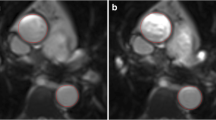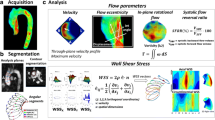Abstract
Bicuspid aortic valve (BAV) is the most common congenital heart defect and can lead to severe complications. Many studies have been conducted to evaluate the potential of geometric and hemodynamic biomarkers to predict BAV-related aortopathy. This work proposes a novel semi-automatic protocol to characterize geometry and hemodynamics of aorta and aortic valve based on 2D cine and 4D flow MRI data. The protocol was applied to 12 BAV and 12 control subjects. Statistical differences between the groups were identified and linear regression models were investigated to elucidate the potential of this protocol to investigate the risk of disease progression. Statistical differences between the groups were found for orifice eccentricity, aorta diameter, velocity, jet angle and flow displacement. Key findings of the regression analysis include the association in the proximal ascending aorta between aorta diameter and mean velocity (negative), jet angle (positive) and flow displacement (positive), in the combined cohort. Positive association between flow displacement in the proximal aorta and orifice jet angle in TAV subjects was found. This study represents a pilot application of a protocol for standardized assessment of aortic geometry and hemodynamics associated with BAV disease. Its limited need for user input is advantageous for large cohort studies.







Similar content being viewed by others
References
Barker, A. J., and M. Markl. Editorial the role of hemodynamics in bicuspid aortic valve disease. Eur. J. Cardiothorac. Surg. 39:805–806, 2011.
Barker, A. J., C. Lanning, and R. Shandas. Quantification of hemodynamic wall shear stress in patients with bicuspid aortic valve using phase-contrast MRI. Ann. Biomed. Eng. 38:788–800, 2010.
Barker, A. J., M. Markl, J. Burk, R. Lorenz, J. Bock, S. Bauer, J. Schulz-Menger, and F. von Knobelsdorff-Brenkenhoff. Bicuspid aortic valve is associated with altered wall shear stress in the ascending aorta. Circ. Cardiovasc. Imaging 5:457–466, 2012.
Bissell, M. M., A. T. Hess, L. Biasiolli, S. J. Glaze, M. Loudon, A. Pitcher, A. Davis, B. Prendergast, M. Markl, A. J. Barker, S. Neubauer, and S. G. Myerson. Aortic dilation in bicuspid aortic valve disease: flow pattern is a major contributor and differs with valve fusion type. Circ. Cardiovasc. Imaging 6:499–507, 2013.
Bock, J., B. W. Kreher, J. Hennig, and M. Markl. Optimized pre-processing of time-resolved 2D and 3D Phase Contrast MRI data. 15th Scientific Meeting of the ISMRM, 2007.
Burris, N. S., M. Sigovan, H. A. Knauer, E. E. Tseng, D. Saloner, and M. D. Hope. Systolic flow displacement correlates with future ascending aortic growth in patients with bicuspid aortic valves undergoing magnetic resonance surveillance. Investig. Radiol. 2014. doi:10.1097/RLI.0000000000000064.
Davies, R. R., R. K. Kaple, D. Mandapati, A. Gallo, D. M. J. Botta, J. A. Elefteriades, and M. A. Coady. Natural history of ascending aortic aneurysms in the setting of an unreplaced bicuspid aortic valve. Ann. Thoracic Surg. 83:1338–1344, 2007.
Della Corte, A., C. Bancone, C. Quarto, G. Dialetto, F. E. Covino, M. Scardone, G. Caianiello, and M. Cotrufo. Predictors of ascending aortic dilatation with bicuspid aortic valve: a wide spectrum of disease expression. Eur. J. Cardiothorac. Surg. 31:397–404, discussion 404–5, 2007.
Della Corte, A., C. Bancone, C. A. Conti, E. Votta, A. Redaelli, L. Del Viscovo, and M. Cotrufo. Restricted cusp motion in right-left type of bicuspid aortic valves: a new risk marker for aortopathy. J. Thorac. Cardiovasc. Surg. 144:360–369.e1, 2012.
Della Corte, A., C. Bancone, M. Buonocore, G. Dialetto, F. E. Covino, S. Manduca, G. Scognamiglio, V. D’Oria, and M. De Feo. Pattern of ascending aortic dimensions predicts the growth rate of the aorta in patients with bicuspid aortic valve. JACC: Cardiovasc. Imaging 6:1301–1310, 2013.
den Reijer, P. M., D. Sallee, P. van der Velden, E. R. Zaaijer, W. J. Parks, S. Ramamurthy, T. Q. Robbie, G. Donati, C. Lamphier, R. P. Beekman, and M. E. Brummer. Hemodynamic predictors of aortic dilatation in bicuspid aortic valve by velocity-encoded cardiovascular magnetic resonance. J. Cardiovasc. Magn. Reson. 12:4, 2010.
Frakes, D. H., K. Pekkan, L. P. Dasi, H. D. Kitajima, D. A. de Zélicourt, H. L. Leo, J. Carberry, K. S. Sundareswaran, H. Simon, and A. P. Yoganathan. Modified control grid interpolation for the volumetric reconstruction of fluid flows. Exp. Fluids 45:987–997, 2008.
Girdauskas, E., M. A. Borger, M. A. Secknus, G. Girdauskas, and T. Kuntze. Is aortopathy in bicuspid aortic valve disease a congenital defect or a result of abnormal hemodynamics? A critical reappraisal of a one-sided argument. Eur. J. Cardiothorac. Surg. 39:809–814, 2011.
Go, A. S., et al. Heart disease and stroke statistics–2014 update: a report from the American Heart Association. Circulation 129:e28–e292, 2014.
Hahn, R. T., M. J. Roman, A. H. Mogtader, and R. B. Devereux. Association of aortic dilation with regurgitant, stenotic and functionally normal bicuspid aortic valves. J. Am. Coll. Cardiol. 19:283–288, 1992.
Hope, T. A., M. Markl, L. Wigström, M. T. Alley, D. C. Miller, and R. J. Herfkens. Comparison of flow patterns in ascending aortic aneurysms and volunteers using four-dimensional magnetic resonance velocity mapping. J. Magn. Reson. Imaging 26:1471–1479, 2007.
Hope, M. D., T. A. Hope, A. K. Meadows, K. G. Ordovas, T. H. Urbania, M. T. Alley, and C. B. Higgins. Bicuspid aortic valve: four-dimensional MR evaluation of ascending aortic systolic flow patterns. Radiology 255:53–61, 2010.
Hope, M. D., T. A. Hope, S. E. S. Crook, K. G. Ordovas, T. H. Urbania, M. T. Alley, and C. B. Higgins. 4D flow CMR in assessment of valve-related ascending aortic disease. JACC: Cardiovasc. Imaging 4:781–787, 2011.
Jermihov, P. N., L. Jia, M. S. Sacks, R. C. Gorman, J. H. Gorman, and K. B. Chandran. Effect of geometry on the leaflet stresses in simulated models of congenital bicuspid aortic valves. Cardiovasc. Eng. Technol. 2:48–56, 2011.
Jung, B., P. Ullmann, M. Honal, S. Bauer, J. Hennig, and M. Markl. Parallel MRI with extended and averaged GRAPPA kernels (PEAK-GRAPPA): optimized spatiotemporal dynamic imaging. J. Magn. Reson. Imaging 28:1226–1232, 2008.
Mahadevia, R., A. J. Barker, S. Schnell, P. Entezari, P. Kansal, P. W. Fedak, S. C. Malaisrie, P. McCarthy, J. Collins, J. Carr, and M. Markl. Bicuspid aortic cusp fusion morphology alters aortic 3D outflow patterns, wall shear stress and expression of aortopathy. Circulation 129:673–682, 2014.
Markl, M., A. Harloff, T. A. Bley, M. Zaitsev, B. Jung, E. Weigang, M. Langer, J. Hennig, and A. Frydrychowicz. Time-resolved 3D MR velocity mapping at 3T: improved navigator-gated assessment of vascular anatomy and blood flow. J. Magn. Reson. Imaging 25:824–831, 2007.
McGloughlin, T. Biomechanics and Mechanobiology of Aneurysms. Studies in Mechanobiology, Tissue Engineering and Biomaterials. Berlin: Springer, 2011.
Meierhofer, C., E. P. Schneider, C. Lyko, A. Hutter, S. Martinoff, M. Markl, A. Hager, J. Hess, H. Stern, and S. Fratz. Wall shear stress and flow patterns in the ascending aorta in patients with bicuspid aortic valves differ significantly from tricuspid aortic valves: a prospective study. Eur. Heart J. Cardiovasc. Imaging 14:797–804, 2013.
Michelena, H. I., A. D. Khanna, D. Mahoney, E. Margaryan, Y. Topilsky, R. M. Suri, B. Eidem, W. D. Edwards, T. M. Sundt, and M. Enriquez-Sarano. Incidence of aortic complications in patients with bicuspid aortic valves. JAMA 306:1104–1112, 2011.
Nathan, D. P., C. Xu, T. Plappert, B. Desjardins, J. H. Gorman, J. E. Bavaria, R. C. Gorman, K. B. Chandran, and B. M. Jackson. Increased ascending aortic wall stress in patients with bicuspid aortic valves. Ann. Thoracic Surg. 92:1384–1389, 2011.
Rosset, A., L. Spadola, and O. Ratib. OsiriX: an open-source software for navigating in multidimensional DICOM images. J. Digit Imaging 17:205–216, 2004.
Sievers, H. H., and C. Schmidtke. A classification system for the bicuspid aortic valve from 304 surgical specimens. J. Thorac. Cardiovasc. Surg. 133:1226–1233, 2007.
Sigovan, M., M. D. Hope, P. Dyverfeldt, and D. Saloner. Comparison of four-dimensional flow parameters for quantification of flow eccentricity in the ascending aorta. J. Magn. Reson. Imaging 34:1226–1230, 2011.
Squillacote, A. H. The ParaView Guide: A Parallel Visualization Application. Kitware, 2008.
Sucosky, P. Hemodynamic mechanisms of bicuspid aortic valve calcification and aortopathy. In: Molecular Biology of Valvular Heart Disease. Springer, 2014, pp. 81–94. http://link.springer.com/chapter/10.1007/978-1-4471-6350-3_11.
Tadros, T. M., M. D. Klein, and O. M. Shapira. Ascending aortic dilatation associated with bicuspid aortic valve: pathophysiology, molecular biology, and clinical implications. Circulation 119:880–890, 2009.
Acknowledgments
The authors would like to acknowledge the members of the Cardiovascular Fluid Mechanics Laboratory at Georgia Institute of Technology, for the fruitful discussions on the study and the useful comments provided on the manuscript, and Dr. James Bethel (Westat, Rockville, MD, USA) for his advice on the statistical analysis. This study was funded in part by NHLBI Grant R01HL115828, American Heart Association Scientist Development Grant 13SDG14360004 and K25HL119608 (AJB) and the Wallace H Coulter Distinguished Faculty Chair endowment (APY, LM).
Conflict of interest
No benefits in any form have been or will be received from a commercial party related directly or indirectly to the subject of this manuscript.
Author information
Authors and Affiliations
Corresponding author
Additional information
Associate Editor Peter E. McHugh oversaw the review of this article.
The work performed by Lucia Mirabella was carried out during her appointment at Wallace H. Coulter Department of Biomedical Engineering, Georgia Institute of Technology and Emory University, Atlanta, GA, USA.
Rights and permissions
About this article
Cite this article
Mirabella, L., Barker, A.J., Saikrishnan, N. et al. MRI-based Protocol to Characterize the Relationship Between Bicuspid Aortic Valve Morphology and Hemodynamics. Ann Biomed Eng 43, 1815–1827 (2015). https://doi.org/10.1007/s10439-014-1214-2
Received:
Accepted:
Published:
Issue Date:
DOI: https://doi.org/10.1007/s10439-014-1214-2




